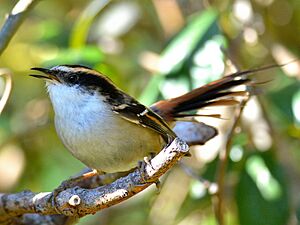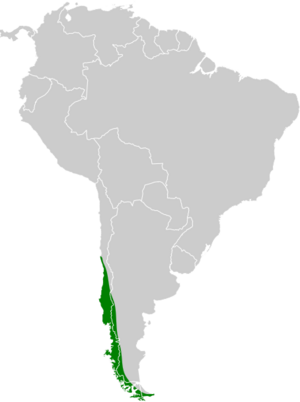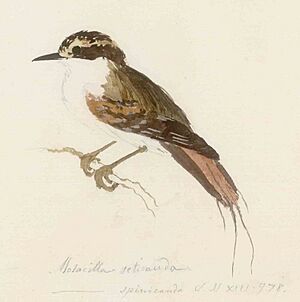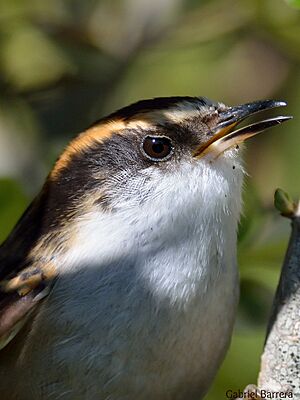Thorn-tailed rayadito facts for kids
Quick facts for kids Thorn-tailed rayadito |
|
|---|---|
 |
|
| Conservation status | |
| Scientific classification | |
| Genus: |
Aphrastura
|
| Species: |
spinicauda
|
 |
|
The thorn-tailed rayadito (Aphrastura spinicauda) is a small bird that belongs to the Furnariidae family. It lives in cool forests and dry shrubland areas in the southern parts of South America, below 30°S latitude. Some people think it might have lived in the Falkland Islands a long time ago. This bird is very common and well-known in the forests of southern Chile. You can often find more than one rayadito in an area the size of a football field!
Contents
About the Thorn-tailed Rayadito
The thorn-tailed rayadito was officially named in 1789 by a German scientist named Johann Friedrich Gmelin. He included it in his updated version of Carl Linnaeus's famous book, Systema Naturae. At first, Gmelin thought it was a type of wagtail and gave it the scientific name Motacilla spinicauda.
Gmelin learned about this bird from John Latham, an English bird expert. Latham had described and drawn the "thorn-tailed warbler" in his own book. The drawing came from Georg Forster, who was an artist on James Cook's second trip around the world. Forster drew the bird in December 1774 when they were in Tierra del Fuego. This original drawing is now kept at the Natural History Museum, London. Today, the thorn-tailed rayadito is grouped with the Masafuera rayadito in a special bird group called Aphrastura. This group was created in 1899 by an American bird expert named Harry C. Oberholser.
Different Kinds of Rayaditos
There are four known types, or subspecies, of the thorn-tailed rayadito:
- A. s. spinicauda (Gmelin, 1789) – Found in central and southern Chile, and western and southern Argentina.
- A. s. bullocki (Chapman, 1934) – Lives on Mocha Island off the coast of Chile.
- A. s. fulva (Angelini, 1905) – Lives on Chiloé Island off the coast of Chile.
- A. s. subantarctica (Rozzi and others, 2022) – Found on the Diego Ramírez Islands far south of Chile.
The A. s. subantarctica type was recently (in 2022) described as its own separate species, called the Subantarctic rayadito. Scientists found differences in its genes, looks, and behavior.
What Does It Look Like?

The thorn-tailed rayadito is about 14 centimetres (5.5 in) long, including its tail. An adult bird usually weighs around 11 grams (0.39 oz). Male rayaditos are about 10 percent heavier than females.
One of the most special things about this bird is its long, "thorn"-like tail. It has twelve stiff tail feathers that look a bit spiny. Young rayaditos slowly grow this tail as they get older. People used to think this tail helped them climb trees, like some other birds. But now, scientists believe the spiny tail is used to attract a mate during courtship.
The feathers of the thorn-tailed rayadito are mostly brown with some black stripes on top. The main type, Aphrastura spinicauda spinicauda, is generally white underneath. However, the Aphrastura spinicauda fulva type from Chiloé has a cinnamon-colored throat instead of white. The Aphrastura spinicauda bullocki type from Mocha Island is completely brown on its back without black stripes, and it has a white throat.
What Sounds Does It Make?
Thorn-tailed rayaditos make several different sounds:
- A loud, fast trill.
- An alarm call that sounds like a scolding "tsii...tsii...tsii."
- A softer, repeated trill that sounds like "trrrrrreet."
- A group call they use when it's not breeding season.
Where Does It Live?
You can find these noisy birds in groups from central Chile and nearby Argentina, all the way south to Tierra del Fuego.
Scientists have studied where rayaditos lived during the Ice Age. When a huge ice sheet covered most of their home, Mocha Island was a very important safe place for them. This suggests that the birds might also have lived east of the ice sheet in Argentina. When the ice melted, the birds could spread out and mix their genes.
How Does It Live?
Like most birds in its family, the thorn-tailed rayadito eats only insects. It's a lot like the tits you might see in other parts of the world. It searches for small insects on tree bark and moss.
When it's not breeding season (from March to September), rayaditos form large groups with other bird species. They are usually so many that they outnumber all the other birds combined! Sometimes, rayaditos are the only birds in the group. Other times, you might see them with white-throated treerunners, striped woodpeckers, and fire-eyed diucons. Rayaditos themselves usually gather in groups of four to seven birds during this time. But during the breeding season (from October to February), they stick to their own territories in pairs.
Rayaditos are very curious and brave birds. They often come close to humans in their forest homes. They can live in many different types of forests. This includes tall Nothofagus and Araucaria forests in the north, to shorter subantarctic forests in the far south. They also live in drier Austrocedrus forests in the eastern part of their range. However, rayaditos don't go into the very dry "scrub beech" forests further east. They generally need good forest paths to move around, though not as wide as some other birds that live in Patagonian forests.
Reproduction and Family Life
Scientists have studied how the thorn-tailed rayadito breeds more than almost any other bird in South America south of the Amazon Basin. Unlike most birds in their family, rayaditos build their nests in holes that are already in old trees. Sometimes, in the far south, they might even nest in holes on the ground. They are also happy to use nest boxes that people put out for them.
Rayaditos lay eggs between October and January. They usually lay three or four eggs. Sometimes they lay more, but it's rare for more than four young birds to successfully leave the nest. One amazing thing about rayaditos and many other birds in their family is how big their eggs are! Even though their eggs are not as big as those of the Des Murs's wiretail, they are still about 50 percent larger than you would expect for a bird that weighs only 11 grams. Because their eggs are so big, female rayaditos (and other birds in their family) lay an egg only every other day. This is similar to other birds in the southern parts of the world, like the rifleman. However, their eggs don't take as long to hatch.
People used to think rayaditos had many sets of babies each year. But studies on Chiloé Island show that each pair usually raises only one group of young per year. Sometimes, they might even get rid of an egg after laying it, but this is very rare for birds in the southern temperate zones. The young birds grow slowly in the nest. They stay in the nest for 21 days before they can fly. After they leave the nest, their parents take care of them for about 30 more days. This is longer than birds in northern temperate areas, but not as long as some birds in tropical places, Australia, or southern Africa, where young birds might not be independent for over 60 days. Young rayaditos might even travel with their parents during the non-breeding season, but scientists are still studying this. The oldest known rayadito, found through bird banding, was six years and four months old. We don't know how long they can live in total.



